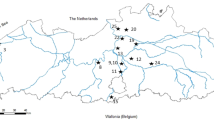Abstract
A five-step sequential extraction procedure was applied on dried and wet Ballastplaat Scheldt estuary sediments. When wet (fresh) sediments were used, all sample handling up to the 3rd extraction step, inclusive, was carried out under inert atmosphere. The repeatability of the procedure was very good on dry samples. For Fe as for Mn, RSD values are lower than 4%, except for Mn in the fifth extraction step where a spread of 10% is observed. The observed RSDs for Pb are of the same order of magnitude as those for Mn. On wet samples the spread of the results is higher than on dried ones. The highest RSDs observed for Fe amount to 20%, for Mn to 15% but for Pb an RSD of up to 44% was found. Better homogenization of the solid sediment part of lyophilized sediments and different porosities of wet sediment sub-samples may be the explanation. These results also indicated that drying/oxidizing of the sediment sample causes a shift from less available/mobile metal fractions to more available/mobile fractions. The Mn and Fe oxyhydroxide spikes added to a wet sediment sample were recovered between 100±10%. The results obtained after changing the sequence of the extraction steps (multiple rotations and inversions were tested) corroborated the progressive increase in the aggressive nature of the extraction solutions in our standard scheme. Although there is also no need to change the ratio volume of extractant to amount of sediment, increasing the number of extraction repetitions in steps 1 to 3 resulted, for some of those extraction steps, in a partially modified analyte distribution. Finally the method was applied to sandy and muddy sediment cores of the Scheldt estuary and revealed clear differences between metal distributions in both types of sediment.




Similar content being viewed by others
References
Baeyens W (1992) Trends Anal Chem 11:245–254
Horvat M, Bloom N, Liang L (1993) Anal Chim Acta 281:135–152
Michel P, Averty B, Andral B, Chiffoleau J-F, Galgani F (2001) Mar Pollut Bull 42:1128–1132
De Gieter M, Leermakers M, Van Ryssen R, Noyen J, Goeyens L, Baeyens W (2002) Arch Environ Contam Toxicol 43:406–417
Tessier A, Campbell PGC, Bisson M (1979) Anal Chem 51:844–851
Salomons W, Förstner U, (1980) Environ Technol Lett 1:506–517
Quevauviller Ph, Rauret G, Lopez-Sanchez J-F, Rubio R, Ure A, Muntau H (1997) Sci Tot Environ 205:223–234
Rauret G, Lopez-Sanchez J-F, Sahuquillo A, Rubio R, Davidson C, Ure A, Quevauviller Ph (1999) J Environ Monit 1:57–61
Robbins JM, Lyle M, Heath GR (1984) Corvallis Oregon State University College of Oceanography
Förstner U, Calmano W (1982) Vom Wasser 59:83–92
Marin P (1988) PhD thesis, University of Caen, France
Jackson ML (1958) Soil chemical analysis. Prentice Hall, Englewood Cliffs, New Jersey
Gibbs RJ (1973) Science 180:71–73
Engler RM, Brannon JM, Rose J, Bingham G (1977) A practical selective extraction procedure for sediment characterisation. In: Yen TF (ed) Chemistry of marine sediments. Ann Arbor, 163–171
Patchineelam SR (1975) Dissertation, University of Heidelberg Germany
Deurer R, Förstner U, Schmoll G (1978) Geochim Comochim Acta 42:425–427
Chao LL (1972) Soil Sci Soc Am Proc 36:764–768
Schwertmann U (1964) Z Pflanzenernähr Bodenkd 105:194–202
Scheinost A, Kretzschmar R, Pfister S, Roberts DLR (2002) Environ Sci Technol 36:5021–5028
Chester R, Hughes MJ (1967) Chem Geol 2:249–262
Holmgren GS (1967) Soil Sci Soc Am Proc 31:210−211
Cooper BS, Harris RC (1974) Mar Pollut Bull 5:24–26
Volkov II, Fomina LS (1974) Influence of organic matter and processes of sulfide formation on the distribution of some trace elements in deepwater sediments in the Black Sea. In: Degens ET, Ross RA (eds) The Black Sea—geology chemistry and biology. Am Assoc Petrol Geol Memoir 20:456–476
Kersten M, Förstner U (1987) Mar Chem 22:299–312
Benjamin MM, Leckie JO (1981) J Colloid Interface Sci 79:209–221
Pickering WF (1988) Talanta 35:559–566
Campanella L, D'Orazio D, Petronio BM, Pietrantonio E (1995) Anal Chim Acta 309:387–393
Quevauviller P, Rauret G, Griepink B (1993) Int J Environ Anal Chem 51:231–235
Thomson EA, Luoma SN, Cain DJ, Johanson C (1980) Water Air Soil Pollut 14:215–233
Bordas F, Bourg ACM (1998) Water Air Soil Pollut 103:137–149
Davidson cm, Wilson LE, Ure AM (1999) Fresenius J Anal Chem 363:134–136
Nirel PMV, Morel FMM (1990) Water Res 24:1055–1056
Nirel P, Thomas AJ, Martin JM (1986) A critical evaluation of sequential extraction techniques. In: Bulman RA, Cooper RJ (eds) Speciation of fission and activation products in the environment. Elsevier, London
Belzille N, Lecompte P, Tessier A (1989) Environ Sci Technol 23:1015–1020
Wallmann K, Kersten M, Gruber J, Förstner U (1992) Trace metal binding forms in sulfide bearing sediments: thermodynamic equilibrium calculations and sequential extractions, BCR Workshop on single and sequential extraction in sediments and soil, Sitges, Spain, March 1992
Van Ryssen R, Leermakers M, Baeyens W (1999) Environ Sci Pollut 2:75–86
Panutrakul S, Baeyens W (1991) Mar Pollut Bull 22:128–134
Panutrakul S (1993) PhD thesis, Vrije Universiteit Brussel, Belgium
Srinetr V (1997) PhD thesis, Vrije Universiteit Brussel, Belgium
Förstner U, Patchineelam SR (1981) Rapp P-v Reun Cons Int Explor Mer 181:49–58
Tessier A, Campbell PGC (1988) Anal Chem 60:1475–1476
Van Ryssen R, Alam M, Goeyens L, Baeyens W (1998) Water Sci Technol 37:283–290
Calmano W, Mangold S, Welter E (2001) Fresenius J Anal Chem 371:823–830
Dehairs FW, Baeyens W, Van Gansbeke D (1989) Estuar Coast Shelf Sci 29:457–471
Aknowledgement
The authors thank the "Vlaamse Milieu Maatschappij, VMM" for financial and logistic support. The constructive comments of the reviewers improved this paper significantly.
Author information
Authors and Affiliations
Corresponding author
Rights and permissions
About this article
Cite this article
Baeyens, W., Monteny, F., Leermakers, M. et al. Evalution of sequential extractions on dry and wet sediments. Anal Bioanal Chem 376, 890–901 (2003). https://doi.org/10.1007/s00216-003-2005-z
Received:
Revised:
Accepted:
Published:
Issue Date:
DOI: https://doi.org/10.1007/s00216-003-2005-z




